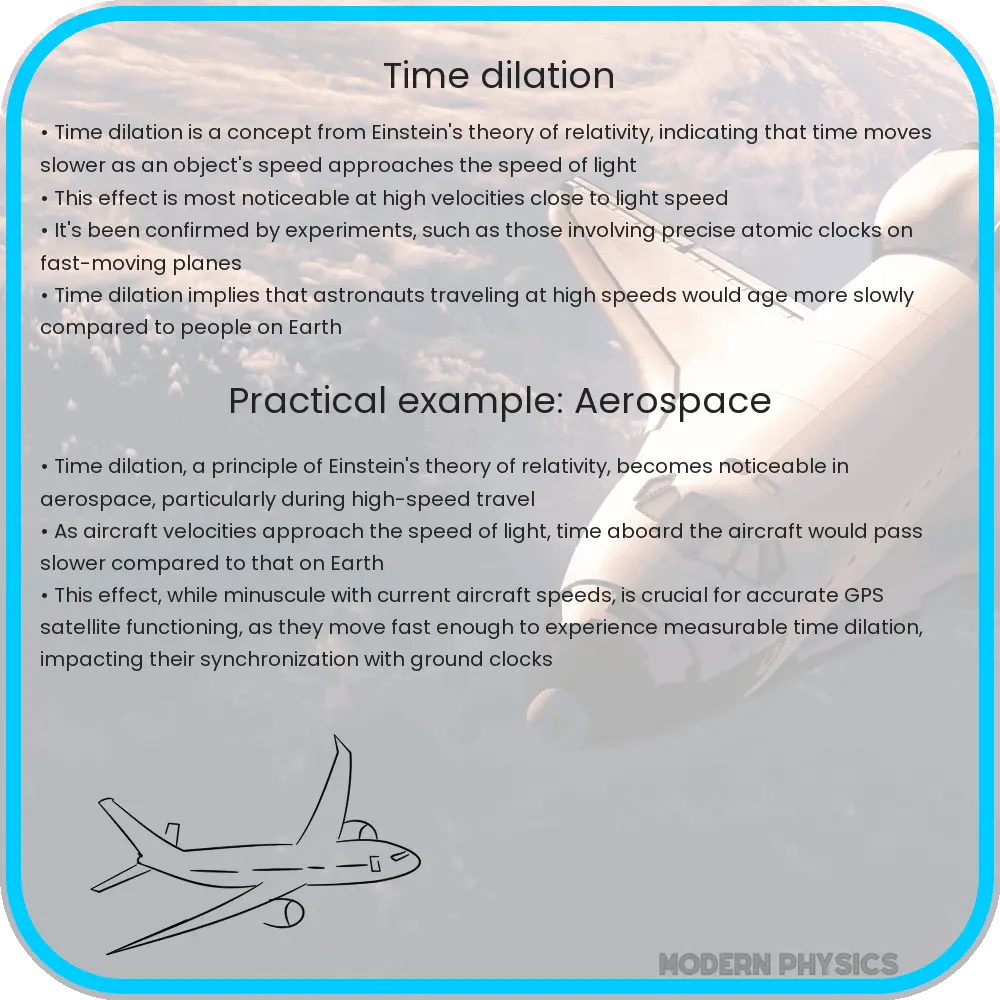Time dilation is a phenomenon where time varies depending on speed and gravity, derived from Einstein’s theories of relativity.

Understanding Time Dilation: From Science Fiction to Science Fact
Time dilation is a fascinating and mind-bending concept that originates from the theory of relativity proposed by Albert Einstein. This phenomenon describes how time, as observed from different frames of reference, can vary significantly depending on the relative speed between the observers. Particularly, time dilation becomes remarkably pronounced at speeds approaching the speed of light. This concept, which may sound like something straight out of a science fiction movie, is a real effect with important implications in physics and cosmology.
The Basics of Time Dilation
The essence of time dilation can be found in Einstein’s theory of special relativity, which addresses the physics of motion at high speeds. Here, one of the key postulates is that the speed of light in a vacuum is the same for all observers, regardless of the motion of the source or the observer. This invariance leads to various relativistic effects, including time dilation.
In simple terms, time dilation means that the time measured by an observer moving at a high velocity appears to pass slower compared to an observer who is at rest. This phenomenon can be quantitatively described using the Lorentz factor, a term denoted as γ (gamma), calculated by:
\[ \gamma = \frac{1}{\sqrt{1 – \frac{v^2}{c^2}}} \]
where:
- v is the velocity of the moving observer relative to the light source,
- c is the speed of light in vacuum (approximately 299,792,458 meters per second).
As the velocity v approaches the speed of light c, the Lorentz factor γ increases, thus magnifying the effects of time dilation.
Real-World Examples and Experiments
One might question the practicality and evidence of time dilation, given its counterintuitive nature. However, this phenomenon has been experimentally confirmed on numerous occasions. For example, experiments involving atomic clocks—a highly accurate type of clock based on the vibrations of atoms—have provided concrete evidence.
In these experiments, two atomic clocks are synchronized. One clock is kept on Earth, while the other is flown around at high speeds in an aircraft. Upon the return of the flying clock, it consistently shows a slight delay compared to the one that remained on Earth. This difference, albeit small, is fully in line with the predictions made by the theory of relativity concerning time dilation.
The Role of Gravity in Time Dilation
Time dilation is not solely influenced by velocity; gravity also plays a critical role. This aspect is covered under Einstein’s theory of general relativity, which extends the scope of special relativity to include gravity. It describes how time runs slower in stronger gravitational fields—a phenomenon known as gravitational time dilation. This effect is less intuitive but can be observed, for instance, in the behavior of time near massive objects like planets, or even more dramatically near black holes, where gravitational forces are extreme.
In summary, while time dilation might appear to be a purely theoretical construct, it is a very real and measurable effect. Its implications stretch beyond academic interest, affecting technologies such as GPS satellites, which must account for these differences in the passage of time at different altitudes and speeds to remain accurate. As our exploration of space continues to expand, understanding and accounting for the effects of time dilation will become increasingly important.
Applications in Modern Technology and Space Exploration
Understanding time dilation has direct applications in modern technology, particularly in the operation of the Global Positioning System (GPS). GPS satellites orbiting the Earth experience both forms of time dilation—velocity-based due to their speed and gravitational due to their altitude relative to Earth’s surface. Engineers must correct the time dilation effects to ensure that the position calculations based on satellite signals are accurate. Without these corrections, GPS services would quickly become inaccurate, leading to errors in navigation and timing systems used worldwide.
Additionally, time dilation is crucial to consider in the field of space exploration. As we send astronauts further into space, the effects of time dilation will become more significant. For missions approaching the speed of light, such as those envisioned for interstellar travel, accounting for time dilation will be essential for synchronizing time between space travellers and Earth.
Educational Implications and Future Prospects
Time dilation also has profound educational implications. It provides a compelling entry point for students and the general public into the intricate world of relativistic physics. By studying this phenomenon, learners can better appreciate the nature of space, time, and the universe as envisioned by modern physics.
Looking ahead, the ongoing research in quantum mechanics and cosmology may yield even more insights into how time dilation interacts with other physical and astronomical phenomena. As our understanding deepens, we may find new ways to utilize this knowledge, potentially leading to advances in technology, space travel, and our basic understanding of the universe’s structure.
Conclusion
The concept of time dilation, from its theoretical origins to its practical applications and educational value, demonstrates the beauty and complexity of physics. Initially a speculative idea from the realm of theoretical physics, time dilation has proven to be a fundamental aspect of how we understand and interact with our universe. It challenges our intuitive concepts of time and space, invites curiosity, and drives innovation across multiple disciplines. As we continue to explore the cosmos and develop new technologies, the lessons learned from time dilation will undoubtedly play a crucial role in shaping the future of human civilization in the cosmos. This blend of deep scientific insights and real-world applications underscores the importance of continuing to explore and understand even the most mind-bending aspects of science.
